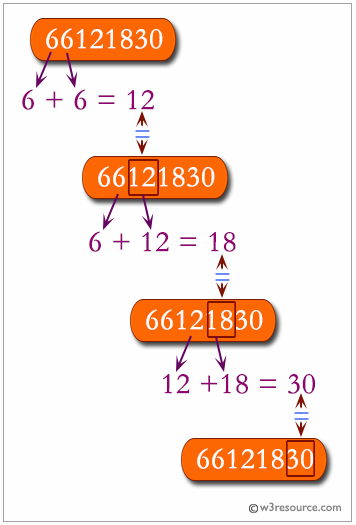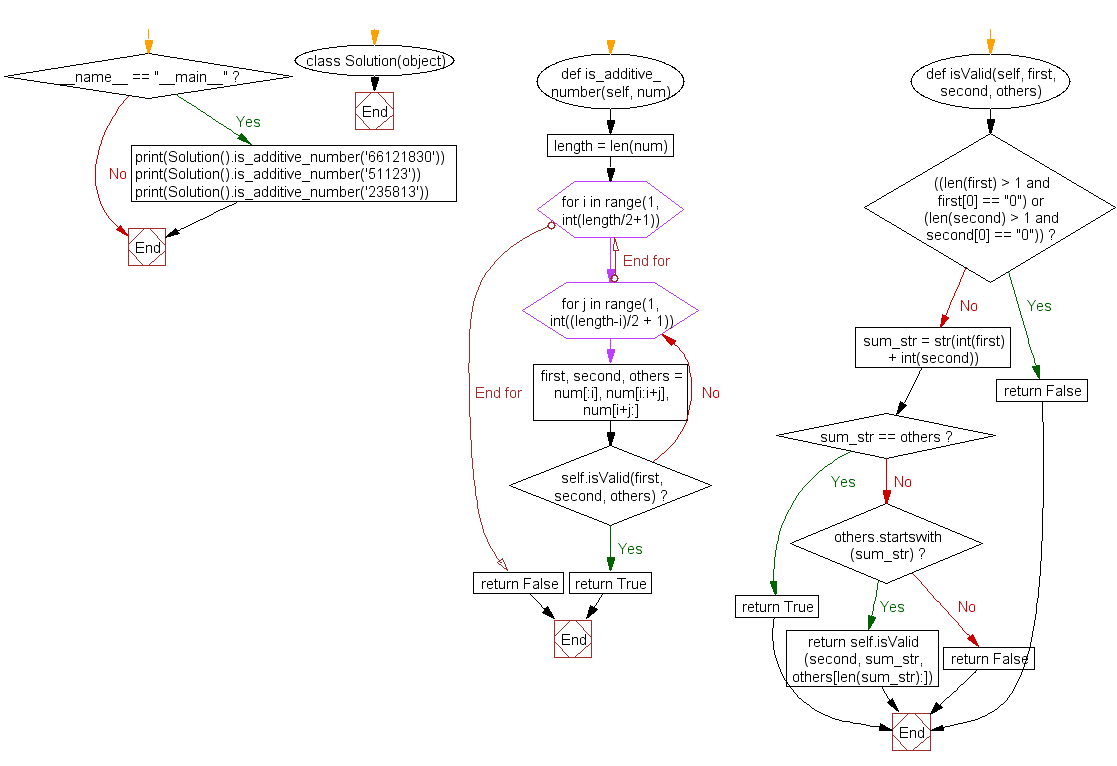Python Challenges: Find whether it contains an additive sequence or not
Python Challenges - 1: Exercise-17 with Solution
Write a Python program to find whether it contains an additive sequence or not.
The additive sequence is a sequence of numbers where the sum of the first two numbers is equal to the third one.
Note: Numbers in the additive sequence cannot have leading zeros.
Explanation:

Sample Solution:-
Python Code:
class Solution(object):
# DFS: iterative implement.
def is_additive_number(self, num):
length = len(num)
for i in range(1, int(length/2+1)):
for j in range(1, int((length-i)/2 + 1)):
first, second, others = num[:i], num[i:i+j], num[i+j:]
if self.isValid(first, second, others):
return True
return False
def isValid(self, first, second, others):
if ((len(first) > 1 and first[0] == "0") or
(len(second) > 1 and second[0] == "0")):
return False
sum_str = str(int(first) + int(second))
if sum_str == others:
return True
elif others.startswith(sum_str):
return self.isValid(second, sum_str, others[len(sum_str):])
else:
return False
if __name__ == "__main__":
print(Solution().is_additive_number('66121830'))
print(Solution().is_additive_number('51123'))
print(Solution().is_additive_number('235813'))
Sample Output:
True False True
Flowchart:

Visualize Python code execution:
The following tool visualize what the computer is doing step-by-step as it executes the said program:
Python Code Editor:
Contribute your code and comments through Disqus.
Previous: Write a Python program to add the digits of a positive integer repeatedly until the result has a single digit.
Next: Write a Python program to reverse the digits of an integer.
What is the difficulty level of this exercise?
Test your Programming skills with w3resource's quiz.
Python: Tips of the Day
Find current directory and file's directory:
To get the full path to the directory a Python file is contained in, write this in that file:
import os dir_path = os.path.dirname(os.path.realpath(__file__))
(Note that the incantation above won't work if you've already used os.chdir() to change your current working directory, since the value of the __file__ constant is relative to the current working directory and is not changed by an os.chdir() call.)
To get the current working directory use
import os cwd = os.getcwd()
Documentation references for the modules, constants and functions used above:
- The os and os.path modules.
- The __file__ constant
- os.path.realpath(path) (returns "the canonical path of the specified filename, eliminating any symbolic links encountered in the path")
- os.path.dirname(path) (returns "the directory name of pathname path")
- os.getcwd() (returns "a string representing the current working directory")
- os.chdir(path) ("change the current working directory to path")
Ref: https://bit.ly/3fy0R6m
- New Content published on w3resource:
- HTML-CSS Practical: Exercises, Practice, Solution
- Java Regular Expression: Exercises, Practice, Solution
- Scala Programming Exercises, Practice, Solution
- Python Itertools exercises
- Python Numpy exercises
- Python GeoPy Package exercises
- Python Pandas exercises
- Python nltk exercises
- Python BeautifulSoup exercises
- Form Template
- Composer - PHP Package Manager
- PHPUnit - PHP Testing
- Laravel - PHP Framework
- Angular - JavaScript Framework
- Vue - JavaScript Framework
- Jest - JavaScript Testing Framework
